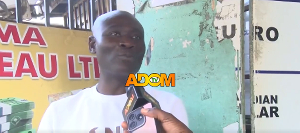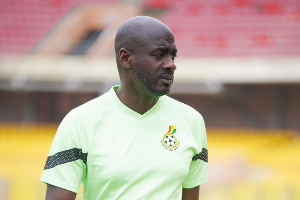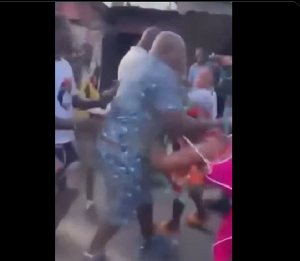“Do you know her personally?” asked a friend. Emmanuel Asumadu had responded to my WhatsApp status that had the picture of Leticia Kyere Pinaman—the young girl alleged to have committed suicide.
Leticia, a final year student of the Miracle Junior High School at Baakonniaba in the Sunyani municipality, had been found dead at the school’s dining hall. The incident happened on Monday evening, May 17, 2021.
I had told my friend that I never knew Leticia. For me, I was only reliving the pain I shared when the issue of the Takoradi girls popped up. It is such a painful situation realizing that a young girl who would have grown to live her dreams had had her life truncated in this cruel manner either by herself or her assassins.
When I sat down to write this piece, for over 30 minutes I kept staring at the Word document opened on my laptop. I groped for words that eluded me like urine to mother hen. The sorrow I share goes beyond the death. It is the fact that we—the bereaved family and Ghanaians at large—may never be able to unravel the mystery of the Miracle JHS girl who suffered in the cold hands of death!
We have seen many of these heinous crimes gathering dusts on the shelves of the Ghana Police Service with nothing substantial being done about them. The deaths of Kwaw Kesse’s former manager Fennec Okyere, former Member of Parliament J.B. Danquah-Adu and that of the Ghana Ports and Habour woman Josephine Tandoh Asante among a host of others are pathetically unresolved. Even the ones purported to have been solved like the Takoradi girls’ saga, a multitude of questions remain to be answered on the investigations done by the police.
In all these, I see that lack of commitment on the part of our Cadet Corps—the police—and technological know-how are the main underlying factors getting people commit all sorts of crime with impunity. Already, the family of Leticia Kyere Pinaman have raised suspicions over the death of their daughter. They believe someone masterminded the heinous act. If their allegation is anything to go by, will the police be able to really bring to book the perpetrators?
In a video I saw on the Facebook page “Abena Manokekame,” two women—one said to be the sister of Leticia and the other her mother—give reasons why they think someone killed the 15-year-old girl.
For Leticia’s mother, suicide must be ruled out of the puzzle. That, the doctor who examined the remains of the girl says once the little girl did not defecate on herself nor had her tongue gushing out and other notable signs of death by suicide, Leticia could have probably been murdered.
Another important point raised by the family is the question of why the legs of the girl touched the floor while she hanged on the rope? Usually, people who hang themselves suspend on the rope or on whatever material they use to kill themselves.
Leticia did not suspend in the air – per what we saw.
Could she have been murdered? That is the question the police must deploy all their arsenals to solve. But one comfortably banking their hopes on the police to do effective investigations is like holding the belief of finding snow in hell.
For two years now, I have been an ardent viewer of Forensic Files—a documentary series on YouTube which details how the American police unravels hardcore crime. Watching these real case scenarios, I get the sense that effective policing that leads to the arrest and prosecution of miscreants hinges on two main things. Evidence (at the crime scene) and interviews.
The last documentary of Forensic Files I watched, recently, that blew my mind is titled the “List Murders.” On that episode, the cruel story of a murderer named John List is told. Mr. List in 1971 murdered his own mother, wife and three children in the family’s apartment. After the crime, he left a note behind explaining why he killed the family and bolted. The man in question gave the police and detectives in America one of the biggest tasks of solving crimes. But, another man by name Frank Bender who ‘merely’ worked as a sculptor would later come in to assist the police trace John List.
In a New York Times’ tribute on the death of Mr. Bender in 2011, it recounted one of the greatest works the forensic sculptor made. That outstanding work was on John List’s case. “Eighteen years later [after List vanished], the television show ‘America’s Most Wanted’ commissioned a bust from Mr. Bender for a segment on Mr. List. Working from an old photograph, he created a balding, jowly figure,” wrote the New York Times.
“In a stroke of inspiration — or perhaps luck — Mr. Bender added glasses with thick black rims,” the paper added, “the kind he felt a strait-laced man like Mr. List would wear.” On May 21, 1989, a woman identified the bust after it was shown on television to be her neighbour named Robert Clark — List had changed his name.
The police arrested him with fingerprint test on him affirming it was the fugitive. John List was a prisoner until his death in 2008. Now, listen to this. I know that you probably fumed over my calling of the Ghana Police Service a cadet corps. It is very much okay to be annoyed with me. But, after reading how the American police resurrected an 18-year old crime committed, teamed up with producers of a television show and subsequently got the forensic sculptor to sculpture the murderer (to exactly look like his then present self), you do not think there is no better description of our police than being a mere cadet corps?
Our police is often interested in petty issues, taking orders from the politician to terrorize innocent people and masters of corruption on our roads. It must, however, be said that a handful of our men and women in uniform are doing their best.
The problem with our police and their inability to unravel crimes committed is a multifaceted one. In the first place, when one pays bribe to be enlisted in the police, you do not expect him or her to come out to serve with a spirit of commitment. They borrow the African politician’s motto — time to chop — and completely abandon their work to fill their pockets.
If this were not the case, the Ghana Police Service should have by now arrested the murderers of investigative journalist Ahmed Suale after composite drawings of the suspects were drawn and published.
In the case of Leticia’s death, I expect the police not ruling out the allegations by her family. Indeed, someone could have murdered her. We are told that the letter she left behind had the exact handwriting of the lady. The truth is, it is possible Leticia’s assailants put her under duress to write the letter or someone could have written it after studying the girl’s handwriting.
Again, I expect that by now the police in Sunyani should have triggered a process to interview all the teachers of the school especially the males. Their phones must be lawfully seized to aid in the investigations. All of Leticia’s classmates and her dining table members and any group or association she joined must equally be interviewed.
Also, DNA investigations should be done on her dress and the rope that she hanged on and such other materials around her death. Dustbins in and around the school and bushes must be scouted for hand gloves and any apparel that might have been used in the ‘killing’.
More so, it will not be an overstretched agenda the police demanding the dresses worn by all teachers and school authorities on the day of her death. Here, the police should first let students attest to dresses their respective teachers and other staff wore that fateful Monday so we are sure they present the right dresses. Even the dresses they wore that evening must be demanded too.
After the dresses are collected, a luminol test must be ran on them to look out for possible trace of stains of blood since we were told there were three cuts on the neck of the young lady. This test must also be done on the floor of the immediate surroundings at the dining hall where Leticia was found hanging. If traces of blood are found in any of these dresses or materials, DNA test is conducted to ascertain whose blood it is.
If the police do a comprehensive investigations into this particular case, the possibility they could demystify the myth behind Leticia’s death would be high. The police must, this time, desist from doing shoddy job as they did in their statement released on April 14, 2021.
They had declared giving out GHC10,000 to anyone who volunteered information on the death of one Charles Kwakye who was shot dead by armed robbers on April 12, 2021, in the Western Region. This method of arresting miscreants is commendable but it should not end there. The police finding a good excuse on why they are probably unlikely to arrest Kwakye’s perpetrators said the robbers “bolted on board two (2) unregistered motorbikes.” The fact that the robbers used unregistered bikes should have had the police deploy a team of detectives to the region to rigorously conduct interviews with residents on these suspects.
It is only a shame that in a country that recently celebrated 64-years of independence, just anyone could ride unregistered vehicles around and even when they are arrested these same police take bribe from them and let them go. Why will people not commit crime with unregistered bikes and vehicles?
We have had enough of the concert party in the system. The police must leave comedy to the comedians and concentrate on their job. We do not want any shoddy job on Leticia’s death as they did on the Takoradi girls!
Opinions of Saturday, 22 May 2021
Columnist: Solomon Mensah



















